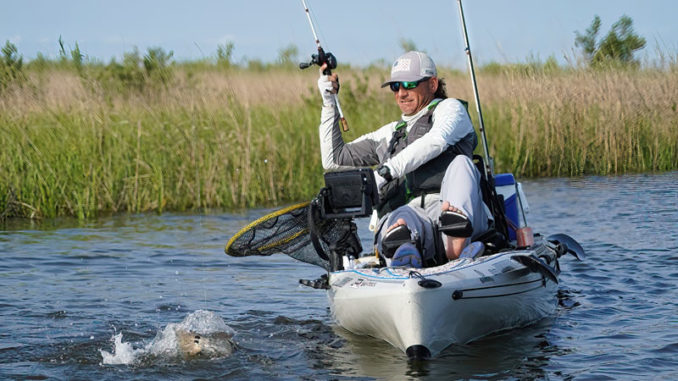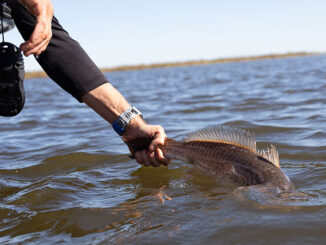
Kayak anglers glide beneath the radar for shallow reds
There may be no better month to chase redfish in a kayak than October. Mild weather with predictable patterns makes it easy to get on a regular bite. Short paddles throughout the marsh can put you on spots to catch several reds without having long treks to areas far from your launch. Teal season is closed and the regular duck season doesn’t open until November. Chasing reds in the shallow marsh and duck ponds is tailor made for kayak fishing.
One of the benefits of kayak fishing is the ability to quietly glide along without spooking fish. Slowly move from spot-to-spot while keeping an eye out for redfish activity. Peer around each corner looking for a tailing fish or a tell-tale “V-wake. Don’t overlook any area. Cast into the smallest cut or pocket, as it just might be holding a fat red.
Although redfish prowl the marsh year-round, as water temperatures begin to drop and the days get shorter, redfish begin concentrating in shallow ponds. Find the bait and find the reds. White shrimp are still in the marsh at this time of year and remain until severe cold weather moves in during the early winter. Scan banks and watch for fleeing shrimp along shorelines where reds love to pen them up for ambush. Also, schools of small pogies and mullets are a sure sign that redfish are nearby.
Shallow draft
Use the advantage of the kayak’s shallow draft to stay close to the shore and cast parallel, rather than staying out and casting directly to the shore. Staying tight to the shoreline where reds prowl keeps the lure in more productive water as you make your retrieve. If the pond has a duck blind, do not overlook casting at and around this structure. Odds are that there will be one or more reds holding near or under the blind.
Not all ponds are the same. Variations in their size and design can often make a big difference in their productivity. Some are more affected by tides than others. Differences in tidal flow varies with depth and bottom structure as well as the growth of submerged grasses. These features help dictate where reds are most likely to be found, and that’s where you should concentrate your efforts. When choosing which pond to fish, look for areas that provide good tidal movement. Find which bank the tide is moving along and that’s where you’ll find the reds.
When the tide is falling, or is low from a recent mild cold front, seek out ponds that have small drains and ditches in the back where bait will be pulled from the flooded marsh. Use the kayak to get where most powerboats cannot. Reds are not shy about shallow water and can regularly be seen tailing while they grub around for food.
Ponds and lagoons with multiple entrances provide more spots to find the fish. Points, cuts and any type of structure are where you’ll most likely find the reds.
Be on the lookout
Keep your eyes and ears peeled. When fishing these shallow areas, reds often give off their presence as their broad bodies move a lot of water. As they feed or simply laze around, wakes or visible tails can easily be seen in these calm, protected waters. The silence of kayak fishing is often broken by the sound of a red crashing bait. Stay attuned to your surroundings. It’s not uncommon to encounter reds within rod distance of the kayak, but then it is often too late. Locating fish allows you to plan and make your casts before you get too close and risk spooking them.
One of the best things about this time of year is that the reds eat virtually anything that comes near them. Bait shops still have live shrimp and many also have cocahoes. While live bait isn’t necessary, many kayakers prefer this almost can’t-miss option. However, a wide variety of lures can be used to trick hungry reds and, of course, dead shrimp is always a favorite.
Dead shrimp on a hook or a small piece tipped on a jighead under a cork has probably accounted for more redfish caught in Louisiana than any other bait. It is a simple, inexpensive combination that is great for beginners and seasoned anglers alike.
Endless choices

However, if you prefer to trick them with artificials, the choices are endless. Weedless gold spoons are an all-time favorite, but spinnerbaits, topwater plugs, crankbaits and a wide variety of soft plastics all do the trick. Redfish are designed for bottom feeding, so scented artificial baits like Gulp can provide an extra advantage.
Fall coastal redfish range from the small “rat” reds, under the 16-inch minimum, to slot reds up to 27 inches. However, don’t be surprised to hook into a tackle-busting bull weighing 10 pounds or more. Fighting one of these giants in shallow water is an epic experience for kayakers.
No special tackle is necessary, but rods with a little backbone and reels with strong, smooth drags help quickly subdue feisty redfish. Kayakers should consider rods long enough so you can easily maneuver your line back and forth across the bow of the kayak. This may become necessary several times during the battle and makes it much more likely that you can successfully land a big fish.
Monofilament line in the 12 to 15-pound range is sufficient; however, some anglers prefer to use braided lines. Whether fishing mono or braid as a main line, a two-foot length of 20-30 pound mono or fluorocarbon leader helps keep reds attached during the fight. Redfish have rough mouths and large, strong, scales and fins. The heavier leader can withstand the abrasion encountered during extended fights as the red makes every effort to gain freedom.
The duck ponds are quiet and the weather is beautiful. If you are a kayak angler, the time is now to head to the shallow marshes across coastal Louisiana for excellent redfish action.


